This morning we had a walking tour around Essaouira with a woman named Rashida, who was quite literally the first Moroccan woman we have really interacted with. Generally speaking, while there are women cooking in the guesthouses we have stayed in or cleaning etc in the hotels, we have not really been able to interact with women in Morocco. In most places all the shop keeps are men, all the guides, drivers and hosts are men, and the women are largely unseen. Rashida is also a bit of an oddity as she is a Gen X lady who has a university education and worked as a teacher for many years, so we were very hopeful of a lot of information from her.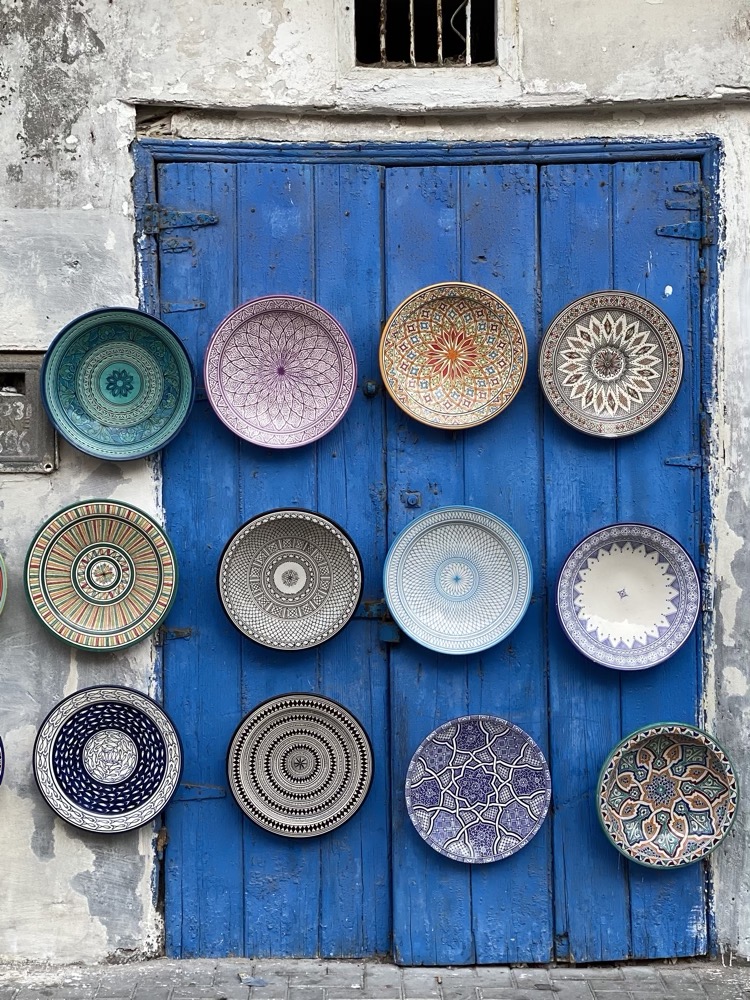 Our first port of call on our walking tour (pun intended) was the harbour where much of the local fishing industry is carried out.
Our first port of call on our walking tour (pun intended) was the harbour where much of the local fishing industry is carried out. 
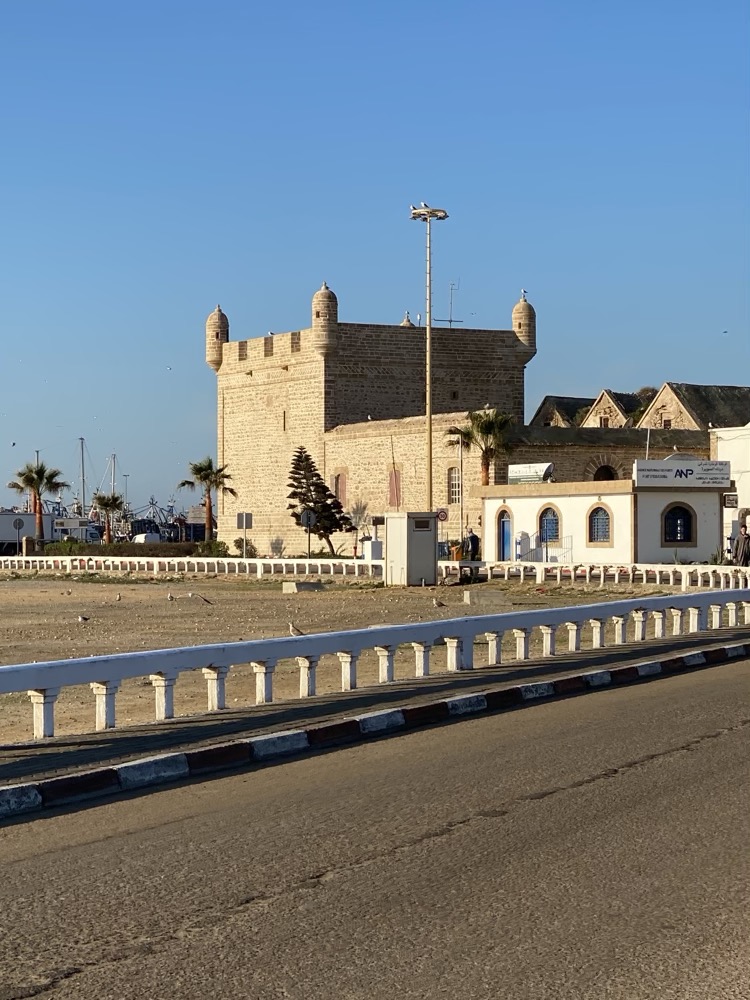 Local fishermen will bring in their catch here and a bustling and busy wholesale fish auction occur every morning – except this morning, which is Sunday. Historically, Essaouira has been occupied since prehistoric times as the bay is fairly adequately protected by Mogador Island, which makes it a very peaceful and protected harbour from the strong Atlantic winds.
Local fishermen will bring in their catch here and a bustling and busy wholesale fish auction occur every morning – except this morning, which is Sunday. Historically, Essaouira has been occupied since prehistoric times as the bay is fairly adequately protected by Mogador Island, which makes it a very peaceful and protected harbour from the strong Atlantic winds.
Essaouira has long been one of the best anchorages on the entire Moroccan coast. A Carthaginian navigator named Hanno wrote of coming here in the 5thC BC to establish a trading post, which made it a strategically important location over the following 2500 years.. Boats here, like in many other countries, are female – and will have a name painted on them. Many of the names are Spanish, Portuguese, or even English, so we could see the Christina or the Maria nearby. The fishermen here are required to paint their boats blue, as they believed that flies are not able to see the blue colour..?
Boats here, like in many other countries, are female – and will have a name painted on them. Many of the names are Spanish, Portuguese, or even English, so we could see the Christina or the Maria nearby. The fishermen here are required to paint their boats blue, as they believed that flies are not able to see the blue colour..?
While we were at the dock, a small boat pulled in a 14′ shark, Rashida called it a ‘clown shark’ but with it’s very long tail fin, it looked like an endangered thresher shark to most of the divers in our group. This shark is destined for the fish markets and will be eaten.

 In the 16thC, Essaouira was occupied by Portugal, ad the King at the time, Manuel I ordered a fortress to be built here – it was called the Castelo Real de Mogador – Essaouira was known as Mogador up until the 1960s. By that time, the Portuguese had control of six Moroccan coastal towns and had built a stand-alone fortress in each town from the start of their occupation in the mid 15thC Most of them were short-lived, being only held for between 5-25 years… by 1541, the fortress at Agadir had fallen to the Saardians (that was the Arab-Moroccan dynasty that ruled Morocco from 1549-1659) and the Portuguese had to abandon all the settlements they had occupied managing only to hold onto Tangier, Cuta and Mazagan.
In the 16thC, Essaouira was occupied by Portugal, ad the King at the time, Manuel I ordered a fortress to be built here – it was called the Castelo Real de Mogador – Essaouira was known as Mogador up until the 1960s. By that time, the Portuguese had control of six Moroccan coastal towns and had built a stand-alone fortress in each town from the start of their occupation in the mid 15thC Most of them were short-lived, being only held for between 5-25 years… by 1541, the fortress at Agadir had fallen to the Saardians (that was the Arab-Moroccan dynasty that ruled Morocco from 1549-1659) and the Portuguese had to abandon all the settlements they had occupied managing only to hold onto Tangier, Cuta and Mazagan.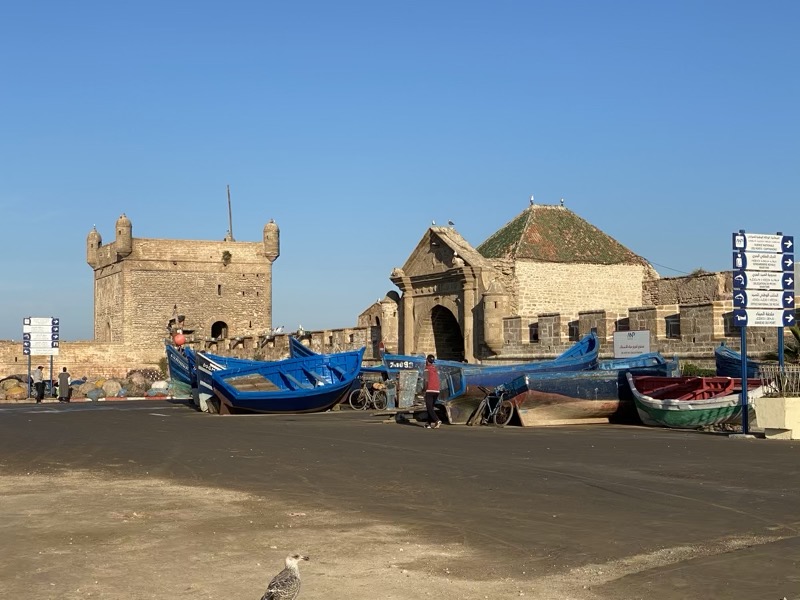


During the following century, several European powers including Spain, England, the Netherlands and France all tried to conquer the region without success and Essaouira remained a haven for the sugar exports of sugar and molasses, and as favourite anchorage for pirates. Yarrrr. Various parts of the fortifications were built and extended on from that time onwards. The present fortifications were built in the 1700s by various French architects – Rashida tells us Moroccans know how to build things, but are not very good at maintaining them.
Various parts of the fortifications were built and extended on from that time onwards. The present fortifications were built in the 1700s by various French architects – Rashida tells us Moroccans know how to build things, but are not very good at maintaining them.  The triumphal arch that joins the harbour to the fortifications represents several different religions that coexisted in the town at that time – the pilgrim’s Shell of Santiago was for the Christians, particularly Spanish Catholics, below it is a Koranic verse along with an Islamic date of 1184, and further below that are crescents for the ‘fertile moon’ which lies between the Tigress and the Euphrates, and if you look closely there are some small stars of David in the flowers on the lozenge motifs. Essaouira had a large Jewish population here, and they were never persecuted like they were in Europe. It was the only safe haven the Jewish had ever known – however on the formation of Israel after WWII 98% of Essaouira’s Jewish population moved to Israel, leaving only about 40-50 Jewish families here now.
The triumphal arch that joins the harbour to the fortifications represents several different religions that coexisted in the town at that time – the pilgrim’s Shell of Santiago was for the Christians, particularly Spanish Catholics, below it is a Koranic verse along with an Islamic date of 1184, and further below that are crescents for the ‘fertile moon’ which lies between the Tigress and the Euphrates, and if you look closely there are some small stars of David in the flowers on the lozenge motifs. Essaouira had a large Jewish population here, and they were never persecuted like they were in Europe. It was the only safe haven the Jewish had ever known – however on the formation of Israel after WWII 98% of Essaouira’s Jewish population moved to Israel, leaving only about 40-50 Jewish families here now. There is an enormous number of cats in this town – they are all very well fed and very well looked after as they keep down the rat population. Essaouira never suffered from the plague due to their harmonious relationship with cats. Here, they collect the cats and desex them, give them shots and keep them healthy – they then dock the cat’s ear. so the community knows they should feed and look after that cat. Cats without their ear docked are to be avoided as they might be diseased. With the rabies.
There is an enormous number of cats in this town – they are all very well fed and very well looked after as they keep down the rat population. Essaouira never suffered from the plague due to their harmonious relationship with cats. Here, they collect the cats and desex them, give them shots and keep them healthy – they then dock the cat’s ear. so the community knows they should feed and look after that cat. Cats without their ear docked are to be avoided as they might be diseased. With the rabies. 


 The town’s cats don’t really belong to anyone, so the town is dotted with cute little cat houses where the cats can go to curl up out of the wind or the summer heat..
The town’s cats don’t really belong to anyone, so the town is dotted with cute little cat houses where the cats can go to curl up out of the wind or the summer heat.. 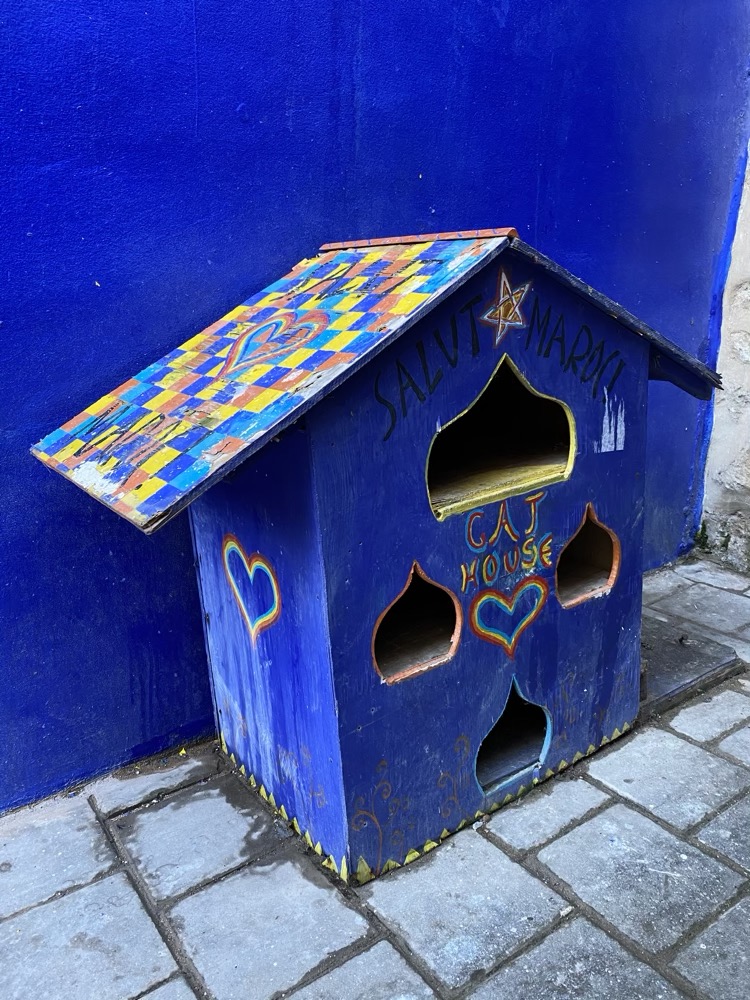 The old arsenal under the fortifications is now filled with shops.
The old arsenal under the fortifications is now filled with shops. 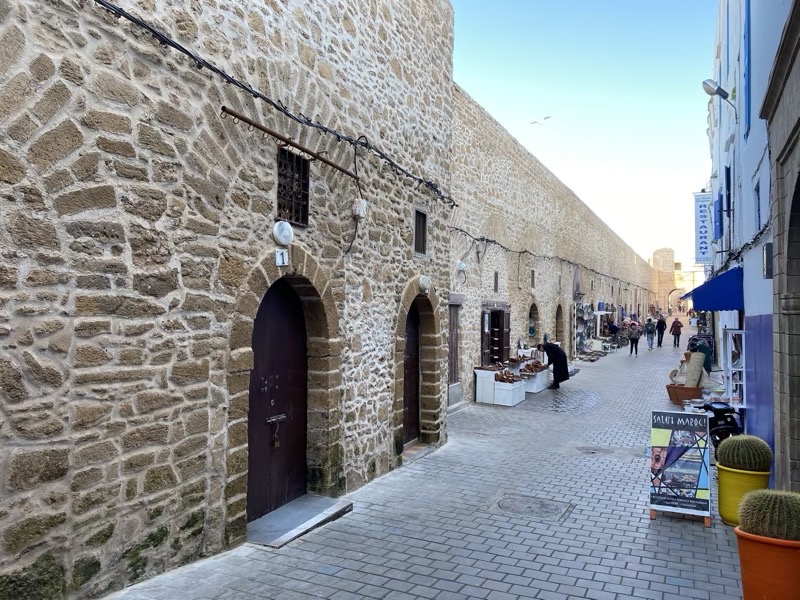
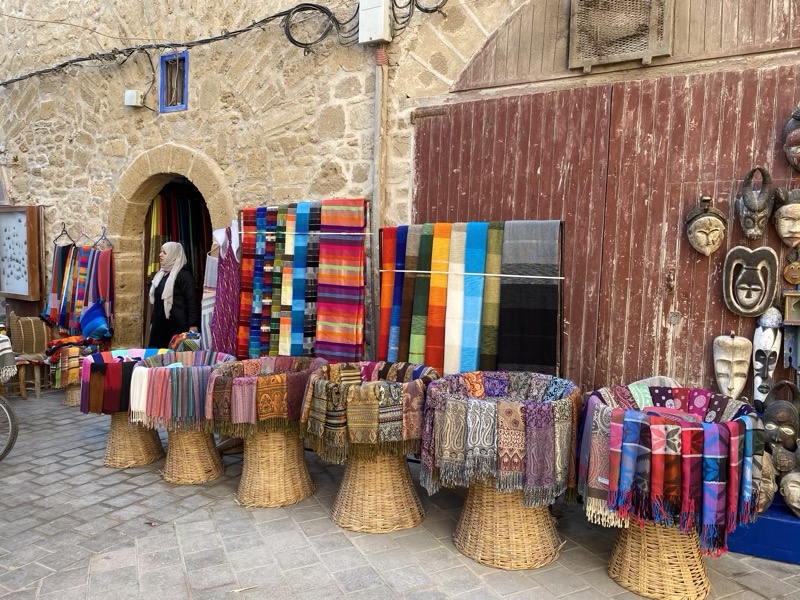 Looking up towards the battlements. The design of the fortress was such that the sounds would echo through the rounded battlements so that one or two cannon could be fired and it would sound like a dozen or more. It was a fairly effective deterrent from invaders arriving from the sea, however, if they did round the corner…
Looking up towards the battlements. The design of the fortress was such that the sounds would echo through the rounded battlements so that one or two cannon could be fired and it would sound like a dozen or more. It was a fairly effective deterrent from invaders arriving from the sea, however, if they did round the corner…  invaders would be greeted by ‘real Moroccan hospitality’, according to Rashida.
invaders would be greeted by ‘real Moroccan hospitality’, according to Rashida. 
 More fat cats – it’s hard to take photos around this area without them.
More fat cats – it’s hard to take photos around this area without them.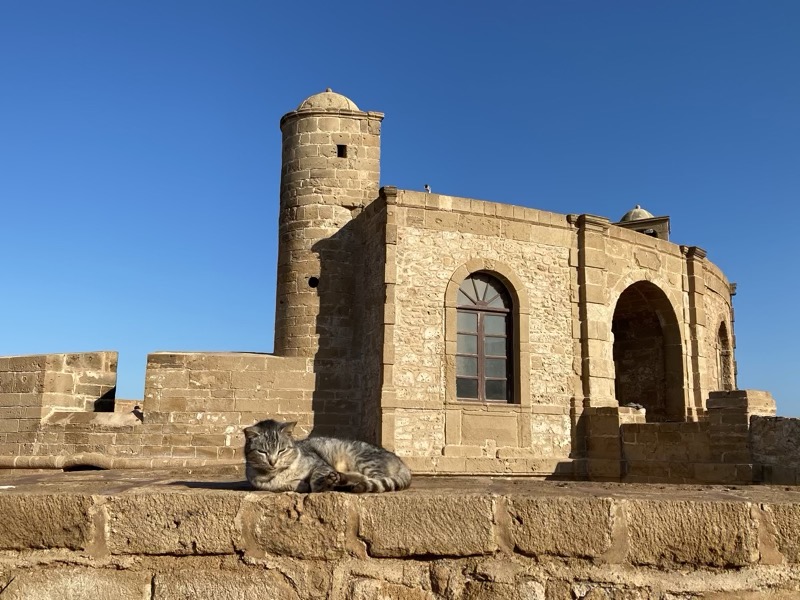
 Some of the canon along the battlement were made/ordered by Carlos III of Spain, others are Danish in origin
Some of the canon along the battlement were made/ordered by Carlos III of Spain, others are Danish in origin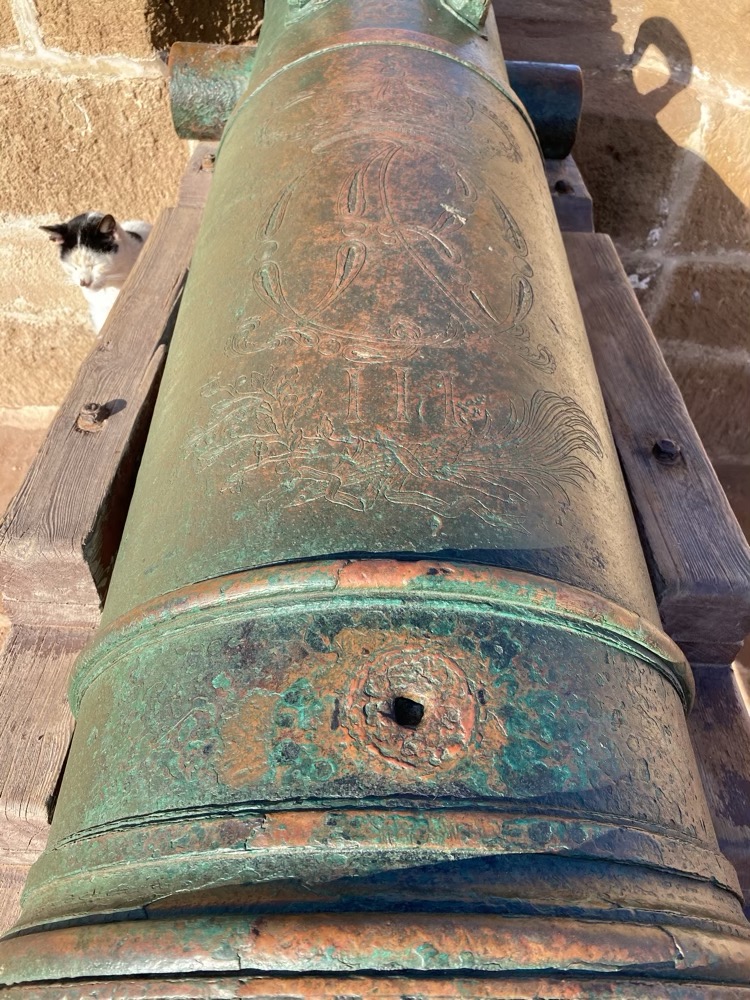



 The medina is much like other towns we have visited, though much more relaxed and laid back. This has become a holiday town for Europeans and has a very European influence in the food, the shopping and the general atmosphere.
The medina is much like other towns we have visited, though much more relaxed and laid back. This has become a holiday town for Europeans and has a very European influence in the food, the shopping and the general atmosphere. 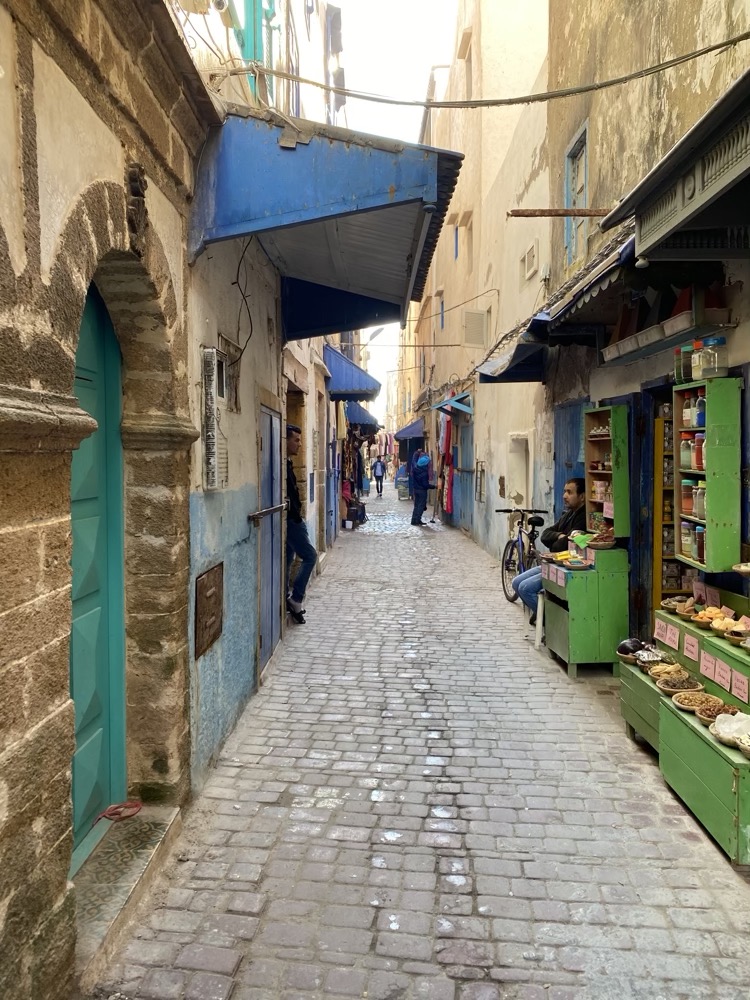 The next place we stopped into was the Centre Artisanal known for its extremely fine handicrafts made from the Thuya timber.
The next place we stopped into was the Centre Artisanal known for its extremely fine handicrafts made from the Thuya timber.  Thuya wood (pronounced two-ya) comes from the Thuya tree (Tetraclinis articulata) which is native only to Morocco…the lovely burled part of the timber is created from a tumour like grown that appears in the tree’s roots.
Thuya wood (pronounced two-ya) comes from the Thuya tree (Tetraclinis articulata) which is native only to Morocco…the lovely burled part of the timber is created from a tumour like grown that appears in the tree’s roots.  The local master craftsman make extremely intricate pieces which have mother of peal, lemonwood, abalone shell and charred timber (to mimic ebony) in ever-increasingly complex patterns and designs. The results are gorgeous.
The local master craftsman make extremely intricate pieces which have mother of peal, lemonwood, abalone shell and charred timber (to mimic ebony) in ever-increasingly complex patterns and designs. The results are gorgeous.

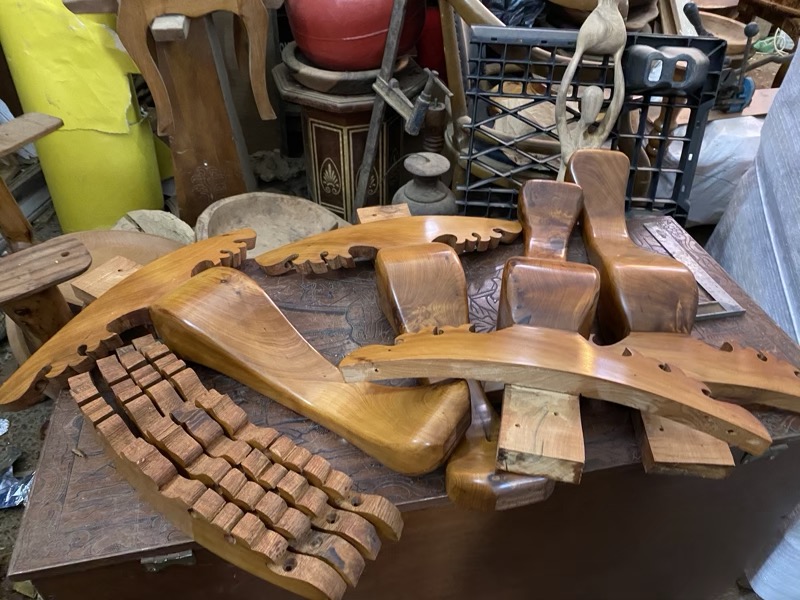 This round table is made of three occasional tables which can be laid out in many different ways to create a zigzag long table or a round table or lotus shape or whatever. It goes for around 16000DH ((AUD$2700). Needless to say, we admired them greatly and left them in the shop!
This round table is made of three occasional tables which can be laid out in many different ways to create a zigzag long table or a round table or lotus shape or whatever. It goes for around 16000DH ((AUD$2700). Needless to say, we admired them greatly and left them in the shop! The various sellers of Thuya wood tend to claim that their industry is sustainable and they are supposed to plant two trees for every one that is cut down, but according to Rashida, the reality is somewhat different and the trees are heading towards being endangered. They take about 30 years to grow to maturity, and they live in a symbiotic relationship with the argan trees… both grow better if planted together.
The various sellers of Thuya wood tend to claim that their industry is sustainable and they are supposed to plant two trees for every one that is cut down, but according to Rashida, the reality is somewhat different and the trees are heading towards being endangered. They take about 30 years to grow to maturity, and they live in a symbiotic relationship with the argan trees… both grow better if planted together.
 It’s gorgeous timber, but most of the pieces are just not things I would use or need. Puzzle boxes, jewellery boxes, trays, bowls, desk accessories, chess sets, domino games and all sorts of beautiful things everywhere..
It’s gorgeous timber, but most of the pieces are just not things I would use or need. Puzzle boxes, jewellery boxes, trays, bowls, desk accessories, chess sets, domino games and all sorts of beautiful things everywhere.. 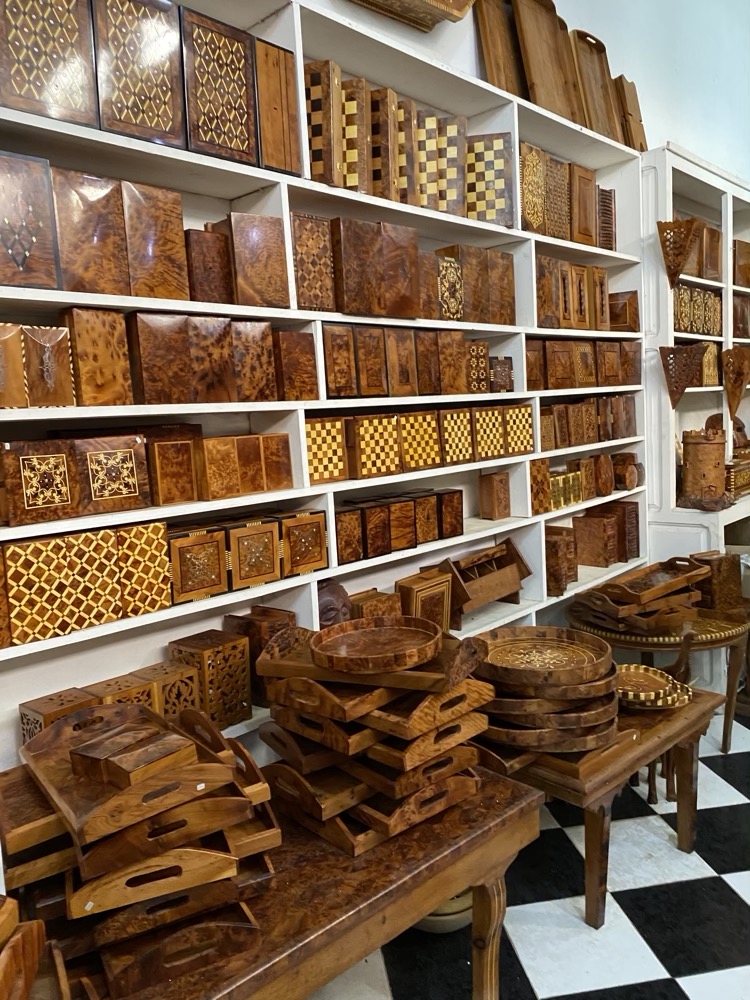
 Outside again, we were headed through the medina towards the fish markets which we expected would be relatively quiet on a Sunday.
Outside again, we were headed through the medina towards the fish markets which we expected would be relatively quiet on a Sunday.  Here, I encountered a man selling lots of traditional pigments,.. the white container with the red lid contains the royal ‘Tyrian purple’ favoured by Romans that comes from crushed sea snails – murex.
Here, I encountered a man selling lots of traditional pigments,.. the white container with the red lid contains the royal ‘Tyrian purple’ favoured by Romans that comes from crushed sea snails – murex.  Around the end of the 1stC BC, the Berber king Juba II established a Tyrian purple factory here in Essaouira, where they processed murex and purpura shells found in the rock pools in the harbour and the Iles Purpuraires. This dye was used to colour the purple stripes in the togas worn by the Senators of Imperial Rome until Caligula decreed that only Roman royalty could wear the royal purple.
Around the end of the 1stC BC, the Berber king Juba II established a Tyrian purple factory here in Essaouira, where they processed murex and purpura shells found in the rock pools in the harbour and the Iles Purpuraires. This dye was used to colour the purple stripes in the togas worn by the Senators of Imperial Rome until Caligula decreed that only Roman royalty could wear the royal purple. 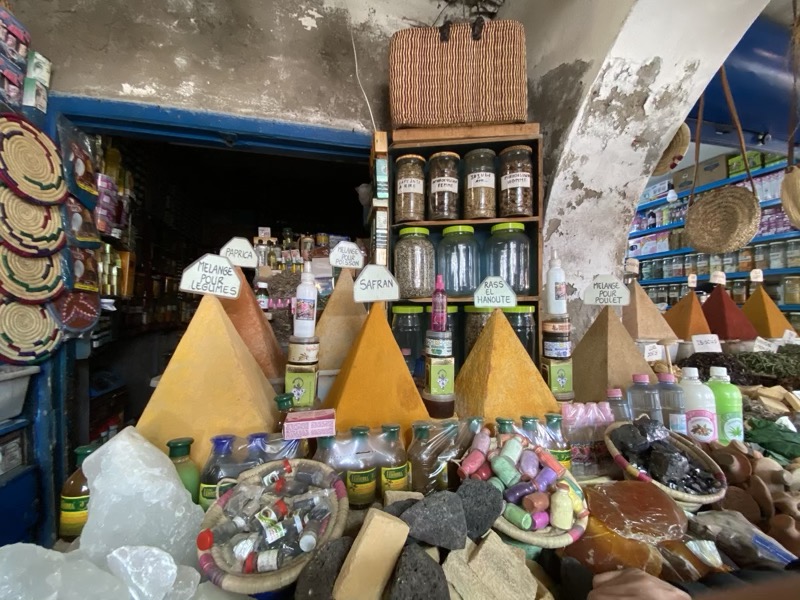 The ground murex is a dark dirty green colour until mixed with water – you can see the purple colour on the edge of the container where it has come into contact with moisture from the sea air.
The ground murex is a dark dirty green colour until mixed with water – you can see the purple colour on the edge of the container where it has come into contact with moisture from the sea air. Fish markety goodness… could be any fishmarket in any country anywhere.
Fish markety goodness… could be any fishmarket in any country anywhere. 
 Next stop was to a workshop for silversmithing – this particular workshop helped deaf people get gainful employment by teaching them to do the fine silver filigree work favoured by the region’s jewellery trade.
Next stop was to a workshop for silversmithing – this particular workshop helped deaf people get gainful employment by teaching them to do the fine silver filigree work favoured by the region’s jewellery trade. 
 We were shown with a touchstone how real silver reacts to acid, and learned a little about traditional Berger designs – most of which seem to be about courtship rituals and symbols of fertility.
We were shown with a touchstone how real silver reacts to acid, and learned a little about traditional Berger designs – most of which seem to be about courtship rituals and symbols of fertility. This Celtic inspired fibular brooch has a large decorative triangular shape attached which is supposed to represent a uterus. It also indicates that a woman is ‘available’… to successfully woo the wearer, her paramour needs to find/have made a matching brooch and hook them together with a heavy silver chain.
This Celtic inspired fibular brooch has a large decorative triangular shape attached which is supposed to represent a uterus. It also indicates that a woman is ‘available’… to successfully woo the wearer, her paramour needs to find/have made a matching brooch and hook them together with a heavy silver chain. Bangles:
Bangles:
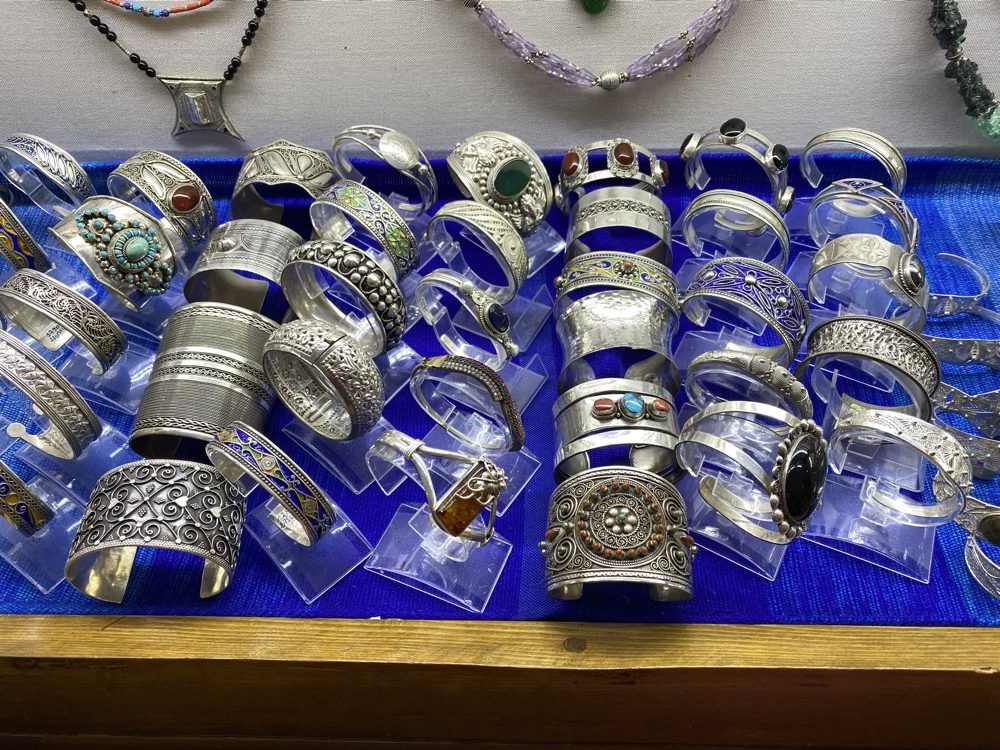 Pendants… oh so many pendants.
Pendants… oh so many pendants.
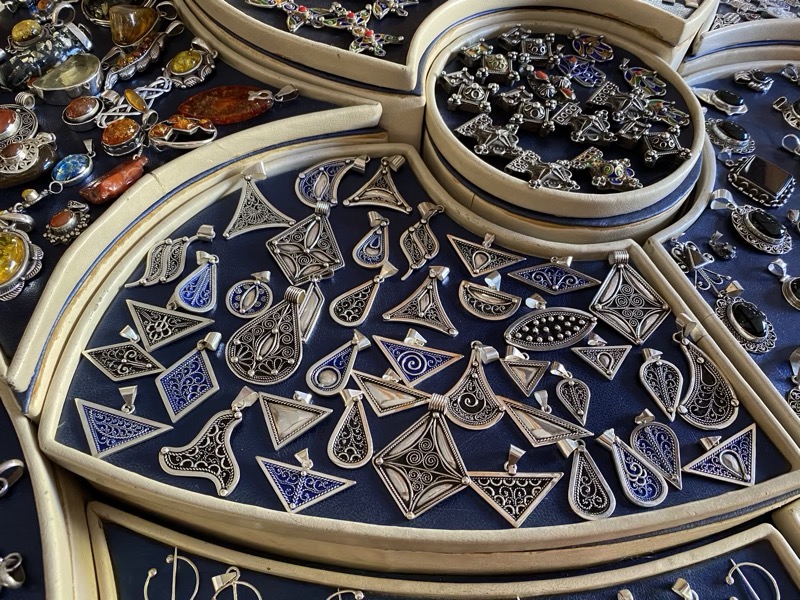 After we checked out the lovely silverwork, we had some quiet time to talk to Rashida about the life of women in Morocco. We had been asking Samirr, ‘Why do we only see men in the shops? How come our hosts in the guesthouses are always men? Where are the women, and can we talk to them?’ A few of us really wanted to talk to an educated woman (someone with good English) who might be prepared to have a frank discussion with us about what it’s like being a woman in an (admittedly fairly progressive) Islamic state.
After we checked out the lovely silverwork, we had some quiet time to talk to Rashida about the life of women in Morocco. We had been asking Samirr, ‘Why do we only see men in the shops? How come our hosts in the guesthouses are always men? Where are the women, and can we talk to them?’ A few of us really wanted to talk to an educated woman (someone with good English) who might be prepared to have a frank discussion with us about what it’s like being a woman in an (admittedly fairly progressive) Islamic state.
The dot points of that conversation went somewhat as follows:
– Morocco has 38% illiteracy, but if you count just the women, that nearly doubles to 65%+
– Most women don’t get an opportunity for education at all, even now, so Rashida being born in the early 70s and university-educated is quite the anomaly – she was sent to school to learn ‘not to be a tomboy’ because she had five older brothers (only three surviving).
– Girls and women are usually ‘kept inside’ from the time of menstruation, so as not to attract the attention of men.
– Arranged marriages are still common, but now women need to appear in court and demonstrate they consent to the marriage (which may or may not be genuine consent).
– The legal age for marriage for girls was increased from 16 to 18 only in 2004, but child marriage still remains quite a problem, especially in rural areas.
– Women have only recently been given the right to divorce their husbands, but men have been able to cast off unwanted wives forever.
– A man can still have three or four wives, but he needs written consent from his existing wives before marrying again… there is literally no mechanism to stop this consent being coerced from the existing wives.
– A widow may remarry but no one would want her as she has been ‘taken and used’ by another man. A man prefers a virginal woman only, so widows tend to remain alone.
– If a woman is raped, her family is likely to offer her as a bride to her rapist. Once ‘used’ she is effectively damaged goods, and no ‘proper family or proper man’ would want her after that. So the only options are to charge the rapist and try to see him sent to jail, or to marry the victim to her rapist so that he might ‘make her respectable’ in the eyes of the village. (Rashida told us a story of an incidence of this occurring to a young 16-year-old victim only 3 years ago, the young girl involved was forced to marry her attacker and unsurprisingly about three or four months later, she committed suicide rather than stay with her ‘husband’ who now had state sanction to keep raping her.
– Children born out of wedlock used to bear their mother’s name either, so the children grew up with the stain of the mother’s sin (or attack) forever. Now they are required to bear the father’s name regardless of the circumstance surrounding their conception, and they have rights to inheritance and upkeep.
– Children automatically stay with their mothers until the age of 12 in the case of a divorce, but the fathers have as much access to their children as they desire – there are no custody battles, the father’s rights supersede the mother’s wishes.
– Domestic abuse is rife, and rarely, if ever, reported.
– Likewise, child abuse and child sexual abuse is never reported – partly because of the stigma and partly because education is so poor, most children are not aware of what is ‘proper’ behaviour from adults, so cases won’t come to light until an abused child has grown up.
– All male children here are circumcised for religious (Jewish) or hygiene reasons, but Morocco never practised female circumcision, ‘that is an African practise, not an Islamic one’.
– Honour killings are rare but unfortunately do still happen in Moroccan Islamic communities.
All up, our half-hour chat with Rashida was very interesting. She was open and frank about her culture as well as her own personal experiences – she is married to a man who had four children from a previous marriage, but was unable to have any children of her own. She is pretty much my age, but already has a handful of step-grandchildren. We were very grateful to have an opportunity to have a talk with her and gain an understanding of the challenges that women face in Morocco… her general feeling is that things are improving, but it’s taking time, and that education and healthcare are the keys to speeding up that process of improvement.
After our chat with Rashida, I met back up with Mr K and we found ourselves a little rooftop terrace for a light lunch. We spent the afternoon doing a bit of shopping and exploring the medina. It wasn’t as busy as we thought the area might be on a Sunday, and we had a much more laid back and friendly shopping experience than we did in Marrakech or Fez. 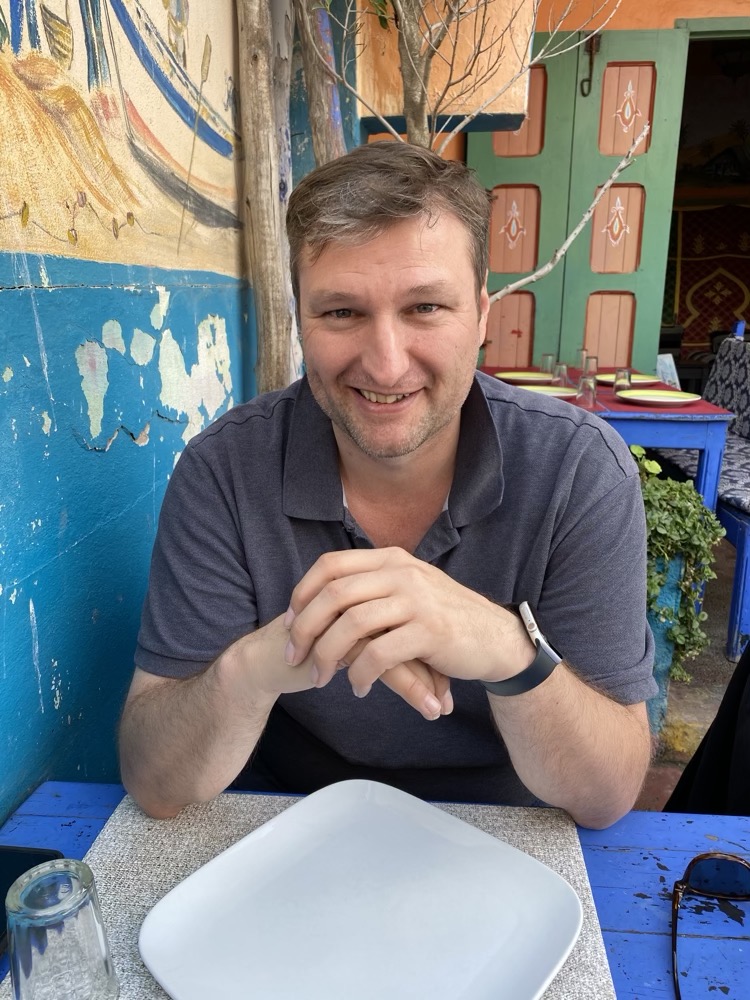 Back at the riad, we ended up having drinks on the rooftop to finally try and get rid of the excess beers that Mohammed had bought for us, and then it was off for a slightly tipsy stumble into the medina to find a restaurant for a light dinner.
Back at the riad, we ended up having drinks on the rooftop to finally try and get rid of the excess beers that Mohammed had bought for us, and then it was off for a slightly tipsy stumble into the medina to find a restaurant for a light dinner.  We have most of the day here tomorrow too, but other than a few last souvenir type errands, we don’t have any plans other than to finally spend a few hours of this vacation chilling (or catching up on backlog of work that is creeping up on us!). Tomorrow, we transit back to Marrakech for the last two days of our trip.
We have most of the day here tomorrow too, but other than a few last souvenir type errands, we don’t have any plans other than to finally spend a few hours of this vacation chilling (or catching up on backlog of work that is creeping up on us!). Tomorrow, we transit back to Marrakech for the last two days of our trip.
